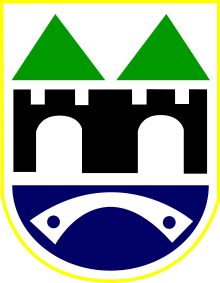Siege of Sarajevo
| Siege of Sarajevo | |||||||
|---|---|---|---|---|---|---|---|
| Part of the Bosnian War | |||||||
 Executive Council Building after being hit by artillery fire | |||||||
| |||||||
| Belligerents | |||||||
|
(1994–96) |
(1992) (1992–96) | ||||||
| Commanders and leaders | |||||||
|
|
(March – July 1992) (July – September 1992) (September 1992 – August 1994) (August 1994 – February 1996) | ||||||
| Units involved | |||||||
|
|
| ||||||
| Strength | |||||||
|
|
| ||||||
| Casualties and losses | |||||||
| 6,137 soldiers killed | 2,241 soldiers killed | ||||||
| 5,434 civilians killed | |||||||
The Siege of Sarajevo was the siege of the capital of Bosnia and Herzegovina, and the longest of a capital city in the history of modern warfare.[3] After being initially besieged by the forces of the Yugoslav People's Army, Sarajevo was besieged by the Army of Republika Srpska from 5 April 1992 to 29 February 1996 (1,425 days) during the Bosnian War. The siege lasted three times longer than the Battle of Stalingrad and more than a year longer than the Siege of Leningrad.[4]
When Bosnia and Herzegovina declared independence from Yugoslavia after the Bosnian independence referendum, 1992, the Bosnian Serbs—whose strategic goal was to create a new Bosnian Serb state of Republika Srpska (RS) that would include Bosniak-majority areas[5]—encircled Sarajevo with a siege force of 13,000[6][7][8] stationed in the surrounding hills. From there they assaulted the city with artillery, tanks and small arms.[9] From 2 May 1992, the Serbs blockaded the city. The Bosnian government defence forces (ARBiH) inside the besieged city, 19 months since start of conflict, numbered some 70,000 troops,[10] were poorly equipped and unable to break the siege.
A total of 13,952 people were killed during the siege, including 5,434 civilians. The ARBiH suffered 6,137 fatalities, while Bosnian Serb military casualties numbered 2,241 soldiers killed. The 1991 census indicates that before the siege the city and its surrounding areas had a population of 525,980. There are estimates that prior to the siege the population in the city proper was 435,000. The estimates of the number of persons living in Sarajevo after the siege ranged from between 300,000 and 380,000.[6]
After the war, the International Criminal Tribunal for the former Yugoslavia (ICTY) convicted four Serb officials for numerous counts of crimes against humanity committed during the siege, including terror: Stanislav Galić[11] and Dragomir Milošević[12] were sentenced to life imprisonment and 29 years imprisonment respectively. Their superiors, Radovan Karadžić[13] and Ratko Mladić, were also convicted.
Background
From its creation following World War II, the government of the Socialist Federal Republic of Yugoslavia kept a close watch on nationalist sentiment among the many ethnic and religious groups that composed the country, as it could have led to chaos and the breakup of the state. When Yugoslavia's longtime leader Marshal Tito died in 1980 this policy of containment underwent a dramatic reversal.
Nationalism experienced a renaissance in the 1980s after violence erupted in Kosovo.[14] While the goal of Serbian nationalists was the centralisation of a Serb-dominated Yugoslavia, other nationalities in Yugoslavia aspired to federalisation and the decentralisation of the state.[15][16]
On 18 November 1990, the first multi-party parliamentary elections were held in Bosnia and Herzegovina (with a second round on 25 November). They resulted in a national assembly dominated by three ethnically based parties, which had formed a loose coalition to oust the communists from power.[17] Croatia and Slovenia's subsequent declarations of independence and the warfare that ensued placed Bosnia and Herzegovina and its three constituent peoples in an awkward position. A significant split soon developed on the issue of whether to stay with the Yugoslav federation (overwhelmingly favored among Serbs) or to seek independence (overwhelmingly favored among Bosniaks and Croats).
The Serb members of parliament, consisting mainly of Serb Democratic Party (SDP) members, abandoned the central parliament in Sarajevo, and formed the Assembly of the Serb People of Bosnia and Herzegovina on 24 October 1991, which marked the end of the tri-ethnic coalition that governed after the elections in 1990. This Assembly established the Serbian Republic of Bosnia and Herzegovina on 9 January 1992, which became the Republika Srpska in August 1992.
Throughout 1990, the RAM Plan was developed by the State Security Administration (SDB or SDS) and a group of selected Serb officers of the Yugoslav People's Army (JNA) with the purpose of organizing Serbs outside Serbia, consolidating control of the fledgling SDP, and the prepositioning of arms and ammunition.[18] The plan was meant to prepare the framework for a third Yugoslavia in which all Serbs with their territories would live together in the same state. Alarmed by its existence and possible implementation, the Bosnian government declared independence of Bosnia and Herzegovina, shortly followed by establishing of Serbian National Assembly by Bosnian Serbs.[19]
The declaration of Bosnian sovereignty on 15 October 1991 was followed by a referendum for independence from Yugoslavia on 29 February and 1 March 1992. This referendum was boycotted by the vast majority of the Serbs. The turnout in the independence referendum was 63.4% and 99.7% of voters voted for independence.[20] The city was mostly peaceful except for the Sarajevo wedding shooting at a Serbian wedding.[21] The wedding guests had brandished Serbian flags, which was interpreted by the Muslims present there as a deliberate provocation while the independence referendum had been held. The Bosnian leader Momčilo Krajišnik declared it as a "great injustice aimed at the Serbian people.[22] Within hours, the city was cut off by SDS and barricades were thrown up by masked men.[21]
Violence had broken out in many places during and after the referendum. Armed Muslims known as "Green Berets" also erected barricades in and around Sarajevo. Barricades were erected near Banja Luka and a motorist was killed by armed Serbs in Doboj. Twelve people were overall killed before fighting died down on March 2.[23] On 3 March, Izetbegović claimed that Serbs from Pale were marching on Sarajevo. Meanwhile, clashes had begun at the same time in the town of Bosanski Brod and eleven Serbs were killed in the village of Sijekovac outside of Brod on 26 March. The SDS stated they were massacred by a Croat-Muslim militia, which was denied though it hardly mattered. The town was besieged and shelled by JNA and Serbian paramilitaries on 29 March in the lead-up to the war.[21] In addition, there were also clashes in Bijeljina which was attacked by a Serb force led by Serb Volunteer Guard. On 4 April, as the information of the killings in Bijeljina came to light, the Bosnian government announced a general mobilisation call. The SDS responded that armed conflict in Sarajevo had moved a step closer with the mobilisation call.[24]
Start of the war
The declaration of independence of Bosnia and Herzegovina by the government alarmed by the RAM plan, was followed by the establishment of a Serbian National Assembly by Bosnian Serbs.[19] The declaration was followed by an independence referendum on 1 March 1992.[20] The referendum passed off mostly peacefully except the shooting at an Orthodox wedding in the old Muslim section of Sarajevo called Baščaršija. The guests brandished Serbian flags, interpreted as deliberate provocation by Muslims at the time of referendum which was mostly supported by them and Bosnian Croats but boycotted by majority of Bosnian Serbs. Nikola Gardović, the groom's father, was killed, while an Orthodox priest was wounded.[22][21] Some of the witnesses identified the shooter as Ramiz Delalić, a minor Bosniak gangster also known as "Ćelo" who had become increasingly brazen since the collapse of communism. Arrest warrants were issued against him and another assailant but little effort was made by the Sarajevo police to arrest them. The killing was denounced by SDS who charged that the failure to arrest them was due to SDA or the government being complicit in it.[25] A SDS spokesman claimed it as an evidence that Serbs were in mortal danger and would be further so in independent Bosnia. This statement was rejected by the founder of Patriotic League Sefer Halilović who stated that it wasn't a wedding but was intended as a provocation.[26]
The next day, Serb paramilitaries set up barricades and sniper positions near Sarajevo's parliament building, but the threatened military coup d'état was thwarted by thousands of Sarajevo citizens who took to the streets in front of the snipers.[27] Following the Republic of Bosnia and Herzegovina's declaration of independence from Yugoslavia on 3 March 1992, sporadic fighting broke out between Serbs and government forces all across the territory.[28] It continued through the run-up to Bosnia and Herzegovina's recognition as an independent state.[29]
On 4 April 1992, when Izetbegović ordered all reservists and police in Sarajevo to mobilize, and SDS called for evacuation of the city's Serbs, came the 'definite rupture between the Bosnian government and Serbs'.[30]
On 5 April, ethnic Serb policemen attacked police stations and then an Interior Ministry training school. The attack killed two officers and one civilian. The Presidency of Bosnia and Herzegovina declared a state of emergency the following day.[29] Later that day, Serb paramilitaries in Sarajevo repeated their action of the previous month. A crowd of peace marchers, between 50,000 and 100,000 comprising all ethnic groups, rallied in protest.[27] On April 5, when a huge crowd approached a barricade, a demonstrator was killed by Serb forces.[31] Six Serb snipers were arrested, but were exchanged when the Serbs threatened to kill the commandant of the Bosnian police academy arrested the previous day with the takeover of the academy.[32][33]
Bosnia and Herzegovina received international recognition on 6 April 1992.[34] The most common view is that the war started that day.[35]
On 6 April Serb forces began shelling Sarajevo, and in the next two days crossed the Drina from Serbia proper and besieged Muslim-majority Zvornik, Višegrad and Foča.[30] All of Bosnia was engulfed in war by mid-April.[30] There were some efforts to halt violence.[36] On 27 April the Bosnian government ordered the JNA to be put under civilian control or expelled, which was followed by a series of conflicts in early May between the two.[37] On May 2 the Green Berets and local gang members fought back a disorganized Serb attack aimed at cutting Sarajevo in two.[37] On May 3, Izetbegović was kidnapped at the Sarajevo airport by JNA officers, and used to gain safe passage of JNA troops from down-town Sarajevo.[37] However, Muslim forces dishonoured the agreement and ambushed the leaving JNA convoy, which embittered all sides.[37] A cease-fire and agreement on evacuation of JNA was signed on 18 May, while on 20 May the Bosnian presidency declared the JNA an occupation force.[37]
The JNA attacked the Ministry of Training Academy in Vraca, the central tramway depot and the Old Town district with mortars, artillery and tank fire, and also seized control of Sarajevo's airport.[11] The Bosnian government had expected the international community to deploy a peacekeeping force following recognition, but it did not materialize in time to prevent war from breaking out across the country.
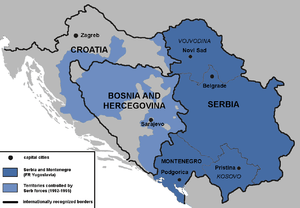
Bosnian Serb and JNA troops overwhelmed the poorly equipped and unprepared government security forces to take control of large areas of Bosnian territory, beginning with attacks on Bosniak civilians in eastern Bosnia. Serb military, police and paramilitary forces attacked towns and villages and then, sometimes assisted by local Serb residents, applied what soon became their standard operating procedure: Bosniak houses and apartments were systematically ransacked or burned; civilians were rounded up, some beaten or killed; and men were separated from the women. Many of the men were forcibly removed to prison camps. The women were incarcerated in detention centres in extremely unhygienic conditions and suffered numerous atrocious abuses. Many were repeatedly raped. Survivors testified that Serb soldiers and police would visit the detention centres, select one or more women, take them out and rape them.[38]
On 22 April, a peace rally in front of the Republic Assembly building was broken up by shots that came from the Holiday Inn.[11] By the end of April, the form of the siege was largely established.
In April 1992, Serb-inhabited Sarajevan suburb of Ilidža saw heavy fighting between the local Serb forces on one side and various Bosniak forces on the other. The local Serbs soon formed the Ilidža Brigade, which became a part of the Sarajevo-Romanija Corps of the VRS.[39]
Early fighting for the city
In the months leading up to the war, JNA forces in the region began to mobilize in the hills surrounding Sarajevo. Artillery, together with other ordnance and equipment that would prove key in the coming siege of the city, was deployed at this time. In April 1992, the Bosnian government under President Alija Izetbegović demanded that the government of Yugoslavia remove these forces. Slobodan Milošević, the president of Serbia, agreed only to withdraw individuals who originated from outside Bosnia's borders, an insignificant number.[6] JNA soldiers who were ethnic Serbs from Bosnia were transferred to the Bosnian Serb Army (VRS) under the command of General Ratko Mladić, with the VRS having rescinded its allegiance to Bosnia a few days after Bosnia seceded from Yugoslavia.
In May 1992, units of the Yugoslav People's Army (JNA) stationed in Sarajevo found themselves repeatedly under attack. On 2 May, Bosniak forces consisting of "Green Berets" and "Patriotic League", opened fire on a column of eight JNA MEDEVAC vehicles in Vojvode Stepe street.[40] This attack caused the JNA to retreat to Serb-held positions in Lukavica district.
On 2 May 1992, Bosnian Serb forces established a total blockade of the city. They blocked the major access roads, cutting supplies of food and medicine, and also cut off the city's utilities (e.g., water, electricity and heating). Although they possessed superior weaponry they were greatly outnumbered by ARBiH soldiers who were defending the city. After numerous JNA armored columns failed to take the city, the Serbs began to concentrate their efforts on weakening it by using continual bombardment from at least 200 reinforced positions and bunkers in the surrounding hills.
On 3 May 1992, members of the Army of Bosnia and Herzegovina (ARBiH) attacked a convoy of withdrawing Yugoslav National Army (JNA) soldiers on Dobrovoljačka Street in Sarajevo, killing 42 and wounding many more.[41] The attack is thought to have been in retaliation for the arrest of Bosnia's Muslim President Alija Izetbegović, who was detained at Sarajevo Airport by Yugoslav police the previous day.[42]
The Army of Republika Srpska was newly established, put under the command of General Ratko Mladić, in a new phase of the war.[37] Shellings on Sarajevo on 24, 26, 28 and 29 May were attributed to Mladić by Boutros-Ghali.[43] Civilian casualties of a 27 May shelling of the city led to Western intervention, in the form of sanctions imposed on 30 May through UNSCR 757.[43] That same day Bosnian forces attacked the JNA barracks in the city, which was followed by heavy shelling.[43] On 5 and 6 June the last JNA personnel left the city during heavy street fighting and shelling.[43] The 20 June cease-fire, executed in order for UN takeover of the Sarajevo airport for humanitarian flights, was broken as both sides battled for control of the territory between the city and airport.[43] The airport crisis led to Boutros-Ghali's ultimatum on 26 June, that the Serbs stop attacks on the city, allow the UN to take control of the airport, and place their heavy weapons under UN supervision.[43] Meanwhile, media reported that Bush considered the use of force in Bosnia.[43] French President Mitterrand visited Sarajevo on 28–29 June.[43] Undramatically, the Serbs handed over the airport to UNPROFOR on 29 June.[43] World public opinion was 'decisively and permanently against the Serbs' following media reports on the sniping and shelling.[44]
On 30 August 1992, an artillery shell crashed into a crowded marketplace on the western edge of Sarajevo. The resulting explosion killed 15 people and wounded 100 others.

On 8 January 1993, Hakija Turajlić, the Deputy Prime Minister of Bosnia and Herzegovina, was assassinated by a Bosnian Serb soldier.[45] Turajlić, who had gone to Sarajevo airport to greet a Turkish delegation, was returning to the city in a United Nations armored vehicle that had taken him there when a force of two tanks and 40–50 Bosnian Serb soldiers blockaded the road. The Serbs, acting on radioed information from a Serbian military liaison officer at the airport that "Turkish fighters" were on their way to reinforce the Bosnian defenders, accused the three French soldiers manning the armored vehicle of transporting "Turkish mujahedeen". After a Serbian military liaison officer identified the passenger as Turajlić, the Serbs ordered the UN soldiers to hand him over. The rear door was opened, and one of the Serbs fired seven shots at Turajlić from an automatic weapon. Six bullets struck him in the chest and arms, killing him instantly.[46] A Bosnian Serb soldier, Goran Vasić, was eventually charged with Turajlić's murder but was ultimately acquitted of that charge in 2002.[47]
Atrocities

The second half of 1992 and the first half of 1993 were the height of the siege of Sarajevo, and atrocities were committed during heavy fighting. Serb forces outside the city continuously shelled the government defenders. Inside the city, the Serbs controlled most of the major military positions and the supply of arms. With snipers taking up positions in the city, signs reading Pazite, Snajper! ("Beware, Sniper!") became commonplace and certain particularly dangerous streets, most notably Ulica Zmaja od Bosne, the main street which eventually leads to the airport, were known as "sniper alleys". The sniper killings of Admira Ismić and Boško Brkić, a mixed Bosnian-Serbian couple who tried to cross the lines, became a symbol of the suffering in the city but it is unknown from which side the snipers opened fire.[48]
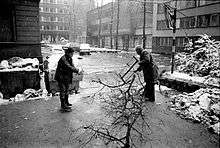
Within Bosniak-held areas of Sarajevo, public services quickly collapsed and the crime rate skyrocketed. During the first year of the siege, the 10th Mountain Division of the ARBiH, led by a rogue commander Mušan Topalović, engaged in a campaign of mass executions of Serb civilians who still lived within the Bosniak-held areas. Many of the victims were transported to the Kazani pit near Sarajevo, where they were executed and buried in a mass grave.[49][50]
Bosnian Serb offensives were mounted to take over some neighborhoods, especially in Novo Sarajevo. To counterbalance the siege, on 30 May 1992 the Security Council demanded Sarajevo Airport be included in a Sarajevo security zone,[51] which was opened to UN airlifts in late June; Sarajevo's survival became strongly dependent on them. Compared with the siege force, the Bosnian government forces were very poorly armed. Bosnian black market criminals who joined the army at the outset of the war illegally smuggled arms into the city through Serb lines, and raids on Serb-held positions within the city yielded more. The Sarajevo Tunnel, completed in mid-1993, was a major asset in bypassing the international arms embargo (applied to all parties to the Bosnian conflict, including the defenders of Sarajevo). It helped supplies and weaponry reach the city's defenders, and enabled some inhabitants to leave. The tunnel was said to have saved Sarajevo.

Reports indicated an average of approximately 329 shell impacts per day during the course of the siege, with a maximum of 3,777 on 22 July 1993.[6] This urbicide by shellfire extensively damaged the city's structures, both residential and cultural. By September 1993 it was estimated that virtually all the buildings in Sarajevo had suffered some degree of damage, and 35,000 were completely destroyed.[6] Among buildings targeted and destroyed were hospitals and medical complexes, media and communication centres, industrial complexes, government buildings and military and UN facilities. Other significant buildings damaged or destroyed included the presidency of Bosnia and Herzegovina and the National Library, which was set on fire and burned to the ground, destroying over 1,500,000 volumes and 600,000 serials.[52][53]
The shelling took a heavy toll on residents. Mass killings of civilians, primarily by mortar attacks, made headline news in the West. On 1 June 1993, 11 people were killed and 133 were wounded[54] in an attack on a football game. On 12 July, twelve people were killed while waiting in line for water.
The biggest single loss of life was the first Markale marketplace massacre on 5 February 1994, in which 68 civilians were killed and 200 were wounded. Medical facilities were overwhelmed by the scale of the civilian casualties, and only a small number of the wounded benefited from medical evacuation programmes like 1993's Operation Irma.[55]
NATO intervention
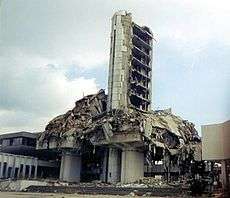
On 6 February 1994, a day after the first Markale marketplace massacre, UN Secretary-General Boutros Boutros-Ghali formally requested NATO to confirm that air strikes would be carried out immediately.[56] On 9 February 1994, agreeing to the request of the UN, the North Atlantic Council of NATO authorized the Commander of Allied Forces Southern Europe (CINCSOUTH), U.S. Admiral Jeremy Boorda, to launch air strikes against artillery and mortar positions in and around Sarajevo that were determined by UNPROFOR to be responsible for attacks against civilian targets.[57][58] Only Greece failed to support the use of airstrikes, but did not veto the proposal.[56] The Council also issued an ultimatum at the 9 February meeting to the Bosnian Serbs demanding that they remove heavy weapons around Sarajevo by midnight of 20–21 February or face air strikes.[56] There was some confusion surrounding compliance with the ultimatum, and Hungarian Prime Minister Péter Boross announced that his country's air space would be closed to NATO aircraft in the event of airstrikes.[56] On 12 February 1994, Sarajevo enjoyed its first casualty-free day in 22 months (since April 1992).[56]
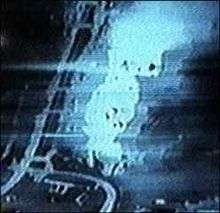
On 5 August, the VRS seized several weapons from the Illidža Weapons Collection site in clear violation of the exclusion zone agreement. During the seizure, the Serbs injured a Ukrainian UNPROFOR peacekeeper. In response to the attack, the UN once again requested NATO air support. Two U.S. A-10 aircraft repeatedly strafed Serb targets, prompting the Serbs to return the seized weapons to the collection site.[59] On 22 September, UNPROFOR again requested NATO air support in the Sarajevo area after Serb forces attacked a French armored personnel carrier. In response, two British SEPECAT Jaguar aircraft struck and destroyed a Serb tank.[60]
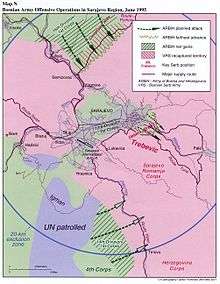
As the fighting gradually widened in 1995, Bosnian Muslim forces launched a large-scale offensive in the area of Sarajevo. In response to the attack, the Bosnian Serbs seized heavy weapons from a UN-guarded depot, and began shelling targets.[61] As a retaliation for these actions, the UN commander, Lt. General Rupert Smith, requested NATO air strikes. NATO honored the request on 25 May and 26 May 1995 by bombing a Serb ammunition dump near Pale.[60] The mission was carried out by USAF F-16s and Spanish Air Force EF-18A Hornets armed with laser-guided bombs.[62] The Serbs then seized 377 UNPROFOR hostages and used them as human shields for a variety of targets in Bosnia, forcing NATO to end its strikes.[63]
On 27 May 1995, Serb soldiers posing as French troops captured two UN observation posts at either end of the front-line Vrbanja bridge without firing a shot. They wore French uniforms, flak jackets and helmets, were armed with French weapons and drove a French armoured personnel carrier (APC) – all stolen from UN troops detained outside the city. The soldiers disarmed the 12 peacekeepers at gunpoint. Ten were taken to an unknown destination while two remained on the bridge as human shields. The French responded by sending 30 troops, backed by six light tanks, to storm the northern end of the bridge. Two French soldiers were killed in the clash and five were wounded, while four Serb soldiers were killed and four were taken prisoner. At the end of the day, the Serbs remained in control of the southern portion of the bridge, while the French occupied the northern portion.[64] The Serbs later abandoned the southern portion of the bridge.
In 1995, the international forces firmly turned against the besiegers after the second Markale massacre of 28 August, in which 37 people were killed and 90 wounded. On 30 August, the Secretary General of NATO announced the start of air strikes, supported by UNPROFOR rapid reaction force artillery attacks.[65] On that same day, a French Mirage 2000 was downed by a Bosnian Serb shoulder-fired SAM near Pale.[66]
On 1 September, NATO and the UN demanded the lifting of the siege, removal of heavy weapons from the heavy weapons exclusion zone around Sarajevo, and complete security of other UN safe areas. The Bosnian Serb leaders were given a deadline of 4 September, and the Operation Deliberate Force bombing campaign was suspended. Heavy weapons had not been removed when the deadline passed. On 5 September, air strikes resumed on Bosnian Serb positions around Sarajevo and near the Bosnian Serb headquarters at Pale.
On 14 September, they were again suspended, this time to allow the implementation of an agreement with the Bosnian Serbs which included the withdrawal of heavy weapons from the exclusion zone. Finally, on 20 September 1995, French General Bernard Janvier (Commander of UNPROFOR) and U.S. Admiral Leighton W. Smith, Jr. (CINCSOUTH) agreed that it was not necessary to resume the strikes as the Bosnian Serbs had complied with the UN's conditions. Operation Deliberate Force was terminated.[67]
Lifting of the siege
Fighting escalated on the ground as joint Bosnian and Croatian forces went on the offensive. The Serbs were slowly driven back in Sarajevo and elsewhere, which eventually allowed the city's heating, electricity and water supplies to be restored. A ceasefire was reached in October 1995. On 14 December, the Dayton Agreement brought peace to the country and led to stabilization.
One of the last acts of hostility of the siege occurred at around 6 pm on 9 January 1996, when a single rocket-propelled grenade was fired at a tram running down the main street of Sarajevo, killing a 55-year-old woman, Mirsada Durić, and wounding 19 others.[68] The grenade was fired from the neighborhood of Grbavica, which was held by the Serbs at the time. After the attack, French troops from the Implementation Force (IFOR) searched the building from which the grenade was launched but did not capture the perpetrator(s). No person has ever been arrested for the attack.
The Bosnian government officially declared an end to the siege of Sarajevo on 29 February 1996, when Bosnian Serb forces left positions in and around the city. More than 70,000 Sarajevan Serbs subsequently left the Muslim-controlled districts of the city and moved to the Republika Srpska, taking all of their belongings with them.[69]
Aftermath
Casualties
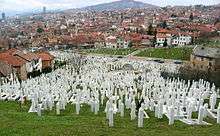
The besieged population comprised not only Bosniaks and Croats, but also Serbs that had remained in the town and who were killed by fire from the besieging VRS forces. The 1991 census indicates that before the siege the city and its surrounding areas had a population of 525,980. There are estimates that prior to the siege the population in the city proper was 435,000. Estimates of the current population range between 300,000 and 380,000. A large number of Sarajevans were killed or wounded throughout the siege. In 1994, a report filed on the total number of deaths over a span of 315 days concluded that 2,474 persons died, with an average of approximately eight killed in the city per day. A report on the total number of persons wounded over a span of 306 days concluded that 13,472 were wounded, an average of approximately 44 per day. This same report estimated the number of people killed or missing in the city to be nearly 10,000, including over 1,500 children. An additional 56,000 people were wounded, including nearly 15,000 children.[6] A report produced by the ICTY after the war put the death toll of the siege at 4,548 ARBiH soldiers and 4,954 Sarajevan civilians killed.[70][71] The Research and Documentation Center in Sarajevo (RDC) found that the siege left a total of 13,952 people dead: 9,429 Bosniaks, 3,573 Serbs, 810 Croats and 140 others. Of these, 6,137 were ARBiH soldiers and 2,241 were soldiers fighting either for the JNA or the VRS. Of the ARBiH soldiers killed, 235 were Serbs, 328 were Croats and the rest were Bosniaks. Sixty percent of all people killed in Sarajevo during the siege were soldiers. In particular, 44 percent of all fatalities were ARBiH personnel. A total of 5,434 civilians were killed during the siege, including 3,855 Bosniaks, 1,097 Serbs and 482 Croats. More than 66 percent of those killed during the siege were Bosniaks, 25.6 percent were Serbs, 5.8 percent were Croats and 1 percent were others. About 14.5 percent of all Bosnian War fatalities occurred in besieged Sarajevo.[72] Officials of the Federation of Bosnia-Herzegovina have estimated that at least 150 Sarajevan Serb civilians were killed by government forces, while some nationalistic groups among Serbs and Republika Srpska officials have put the number at "many thousands". However, efforts to substantiate Bosnian Serb claims have been unconvincing.[73]
The siege affected all sectors of Sarajevo's population. UNICEF reported that of the estimated 65,000 to 80,000 children in the city, at least 40% had been directly shot at by snipers; 51% had seen someone killed; 39% had seen one or more family members killed; 19% had witnessed a massacre; 48% had their home occupied by someone else; 73% had their home attacked or shelled; and 89% had lived in underground shelters. It is probable that the psychological trauma suffered during the siege will bear heavily on the lives of these children in the years to come. As a result of the high number of casualties and the wartime conditions, there are makeshift cemeteries throughout Sarajevo and its surrounding areas. Parks, athletic fields and other open spaces were utilized as graveyards. One such site is the sports complex built for the 1984 Winter Olympics. A 1994 report stated that "the siege has also had a profound effect on the psyche and future of the city's population. The Bosnian Government has reported a soaring suicide rate by Sarajevans, a near doubling of abortions and a 50% drop in births since the siege began."[6]
A memorial with the names of 521 children killed during the siege was unveiled on 9 May 2010. The cases of another 500 children are being verified.[74]

Structural and property damage and destruction
The structural and property damage in Sarajevo as a result of the siege included specifically protected targets such as hospitals and medical complexes, medical facilities (including ambulances) and medical personnel, as well as cultural property, such as the manuscript collection of the Oriental Institute in Sarajevo, one of the richest collections of Oriental manuscripts in the world.[75] For foreigners, an event that defined the besiegers' cultural objectives occurred during the night of 25 August 1992. This was the bombardment – with incendiary shells – that resulted in the total destruction of the irreplaceable National and University Library of Bosnia and Herzegovina, the central repository of Bosnian written culture and a major cultural center for all the Balkans. Among the losses were about 700 manuscripts and incunabula, and a unique collection of Bosnian serial publications, some from the middle of the 19th-century Bosnian cultural revival. Libraries all over the world cooperated afterwards to restore some of the lost heritage, through donations and e-texts, rebuilding the Library in cyberspace.
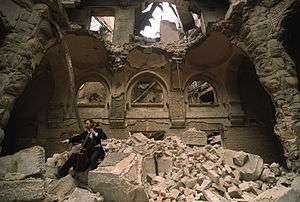
Also unjustified by any military necessity, and equally prohibited, were the attacks on civilian property. The Bosnian government estimated that shelling destroyed over 10,000 apartments and damaged over 100,000 others. Of the other buildings in the city, 23% were reported as seriously damaged, 64% as partially damaged and 10% as slightly damaged. In its report, the Council of Europe's Committee on Culture and Education commented on the structural damage in the city.[6] The Committee stated:
It is plain that Sarajevo has suffered badly at the hands of its attackers. Apart from the obvious human cost in the continued suffering and difficulties of day to day living, there has been serious damage to the urban fabric. The infrastructure (drainage, electricity, telephone services, etc.) is badly damaged. Most buildings are damaged significantly and probably all buildings are damaged to a greater or lesser degree (broken glass etc.). Some buildings have been completely destroyed including ancient monuments (such as the Library) and including a number of modern steel framed buildings (such as the Unis Building) which in some cases have simply collapsed. 35,000 dwellings are also assessed to have been destroyed during the past year.[6]
Sarajevo has made a substantial recovery in terms of the number of buildings that have been fully restored and reoccupied. However, as of 2017, many buildings remained heavily damaged and scarred.
Although the city had been a model for inter-ethnic relations, the siege brought dramatic population shifts. In addition to the thousands of refugees who left the city, many Sarajevo Serbs left for the Republika Srpska, and the percentage of Serbs in Sarajevo decreased from more than 30% in 1991 to slightly over 10% in 2002. Regions of Novo Sarajevo that are now part of the Republika Srpska have formed East Sarajevo, where much of the prewar Serbian population lives today.
New construction projects and foreign capital investment have made Sarajevo perhaps the fastest-growing city in the former Yugoslavia. The population grew to 401,000 in 2002, which is 20,000 fewer than the pre-1991 census estimate.
.jpg)
ICTY convictions
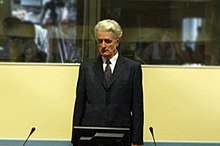
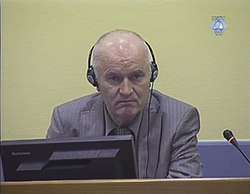
On 5 December 2003 the International Criminal Tribunal for the former Yugoslavia (ICTY) convicted the first commander of the Sarajevo-Romanija Corps, General Stanislav Galić, of the shelling and sniper terror campaign against Sarajevo, including the first Markale massacre.[11] Galić was sentenced to life imprisonment for the crimes against humanity during the siege.[11]
In the case against Stanislav Galić, the prosecution alleged in an opening statement that:
The siege of Sarajevo, as it came to be popularly known, was an episode of such notoriety in the conflict in the former Yugoslavia that one must go back to World War II to find a parallel in European history. Not since then had a professional army conducted a campaign of unrelenting violence against the inhabitants of a European city so as to reduce them to a state of medieval deprivation in which they were in constant fear of death. In the period covered in this Indictment, there was nowhere safe for a Sarajevan, not at home, at school, in a hospital, from deliberate attack.
— Prosecution Opening Statement, ICTY vs Stanislav Galić, 2003[76]
In 2007, General Dragomir Milošević,[12] who replaced Galić as commander of the Sarajevo-Romanija Corps, was found guilty of the shelling and sniper terror campaign against Sarajevo and its citizens from August 1994 to late 1995, including the second Markale massacre. He was sentenced to 29 years in prison. The ICTY concluded that the Markale town market was hit on 28 August 1995 by a 120 mm mortar shell fired from Sarajevo-Romanija Corps positions.[12]
In 2011, the former Chief of the General Staff of the Yugoslav Army, General Momčilo Perišić, was sentenced to 27 years in prison for aiding and abetting murder because the Yugoslav army under his supervision provided "large-scale logistic support in ammunition, fuel and spare parts" as well as "necessary expert assistance" to the VRS during the siege.[77] According to an estimate of the Main Staff from 1994, the VRS received about 25 million bullets and over 7,500 shells from the Yugoslav army to wage the war in Bosnia. However, the judges ruled that Perišić did not have effective control over the VRS officers, who largely fought independently of his instructions yet still received payment and benefits from Belgrade.[77][78] In 2013, Perišić's conviction was overturned and he was released from prison.[79]
On 24 March 2016 Bosnian Serb leader Radovan Karadžić was found guilty of genocide, war crimes and crimes against humanity in Srebrenica and other areas of Bosnia during the war in the 1990s. Karadžić was acquitted of one of those charges of genocide in Muslim regions of Bosnia. He was sentenced to 40 years in prison, with allowance for the time he has already spent behind bars. He has been held since 2008.[80]
Finally, on 22 November 2017, general Ratko Mladić was sentenced to a life in prison.[81][82]
In popular culture
Comics
- Le Sommeil du monstre, a comic book by Enki Bilal.
- Sarajevo Tango, a comic-art by Hermann Huppen
- Fax From Sarajevo, a comic-art by Joe Kubert[83]
- The Fixer, a graphic novel by Joe Sacco
Songs and concerts
- Judy Collins's Sarajevo
- Zubin Mehta conducted the Sarajevo Symphony Orchestra and Chorus in Mozart's Requiem at the ruins of Sarajevo's National Library.
- Laibach from Slovenia performed the first post war concerts in Sarajevo on the 20 and 21 November during the 1995 Nato Occupied Europe Tour.[84]
- In 1994, during the siege, Iron Maiden frontman, Bruce Dickinson and his band Skunkworks performed a concert in Sarajevo. The story of this show is told in the documentary Scream for Me, Sarajevo [85]
- U2's PopMart Tour included a 1997 U2 concert in Sarajevo
- "Miss Sarajevo", a song by U2 and Brian Eno under the pseudonym Passengers
- "Bosnia", a song by The Cranberries from their album To the Faithful Departed
- "Caído en Sarajevo (Fallen at Sarajevo)", a song by Chilean rock band Arka[86]
- "Christmas Eve/Sarajevo 12/24", a song by Savatage and the Trans-Siberian Orchestra
- "Romeo and Juliet in Sarajevo", a Cantonese pop song by Hong Kong singer Sammi Cheng
- "You Stay Here", a song by American singer songwriter Richard Shindell is based on the Siege of Sarajevo
- "Sarajevo Red Line", memorial event which commemorated the Siege of Sarajevo's 20th anniversary
- "Sarajevo", a song by Max Richter
- "Vrbanja Bridge", a song by American singer/songwriter Jill Sobule, which tells of two religiously opposed lovers trying to escape over the Vrbanja bridge.
- "Boško i Admira", a song of band Zabranjeno Pušenje about Boško and Admira, the two lovers of conflicting religions
- "La Geste de Sarajevo", a song by Tri Yann
- "Sarajevo", a song by American rapper/spoken word artist Watsky about the story of Boško and Admira, from his album All You Can Do
- "Σαράγεβο", a song by Greek rock band Magic De Spell. Link includes English translation.
- "Wedding in Sarajevo", a song by the jazz funk outfit, Screaming Headless Torsos.
- "Sarajevo", an orchestral composition by Ramon Caudet.
Musicals and operas
- Circle, a musical by E. Dino Zonic
- Dead Winter Dead, a rock-opera by Savatage, 1995
Plays
- Blasted, a play by Sarah Kane
- The Music Lesson, a play by Tammy Ryan
- Bolero, Sarajevo, a theatre/dance performance directed by Haris Pasovic
- "Sniper", devised work by Kerryn Palmer 2004
- "Stories In The Dark", play by Debra Oswald
Poetry
- The Bosnia Poem: Someone in Sarajevo, poem by Michael Blackburn
- The Cries of Our People – Sarajevo Octets, a book of poetry by Walter Raniowski
- Sarajevo Blues, a book of poetry by Semezdin Mehmedinović
- The Bright Lights of Sarajevo, poem by Tony Harrison
- Why the Dwarf had to be Shot, a book by Sasha Skenderija
Books and stories
- A Temporary Cessation of Hostilities, a story by Tomasz Kamusella.[87]
- Blood And Honey A Balkan War Journal, by Chuck Sudetic, Ron Haviv, David Rieff, Bernard Kouchner ISBN 978-1-57500-135-7
- Besieged: Life Under Fire on a Sarajevo Street, by Barbara Demick
- Đavo u Sarajevu (Devil in Sarajevo), a book by Nenad Veličković
- Empty Casing: A Soldier's Memoir of Sarajevo Under Siege, a book by Canadian peacekeeper Fred Doucette
- Fools Rush In: A True Story of Love, War, and Redemption, by Bill Carter ISBN 978-1-932958-50-8
- Goodbye Sarajevo: A True Story of Courage, Love and Survival, by Atka Reid and Hana Schofield, 2011, ISBN 978-1-4088-1456-7
- Hearts Grown Brutal: Sagas of Sarajevo, by Roger Cohen, 1998, ISBN 0-679-45243-5
- Letters from Sarajevo (Sarajevo: Voci da un assedio 1993), by Anna Cataldi, 1994 (trans. Avril Bardoni) ISBN 1-85230-500-2
- Lie in the dark, a book by Dan Fesperman, 1999, ISBN 978-1-84243-945-6
- My Childhood Under Fire: A Sarajevo Diary by Nadja Halilbegovich
- My War Gone By, I Miss It So, by Anthony Loyd
- Natasha's Story, a book by Michael Nicholson
- No gun for Asmir, a book by Christobel Mattingley
- Not Like My Mother, by Azra Alagic, 2012 ISBN 978-0-9872915-1-6
- Pretty Birds, by Scott Simon, 2005 ISBN 1-4000-6310-8
- The Cellist of Sarajevo, by Steven Galloway
- The Little Red Chairs, by Edna O'Brien
- The Question of Bruno, stories by Aleksandar Hemon, 2000, ISBN 0-375-72700-0
- The Siege of Sarajevo, a book by Suada Kapic
- Regarding the Pain of Others, by Susan Sontag
- Sarajevo, A War Journal, a book by Zlatko Dizdarevic
- Sarajevo Days, Sarajevo Nights, a book by Elma Softic
- Sarajevo, Exodus of a City, a book by Dzevad Karahasan
- Sarajevo Roses, a book by South African UN Peacekeeper Anne-Marie Du Preez Bedroz
- Sarajevski Marlboro (Sarajevo Marlboro), a book by Miljenko Jergović, 1994
- Short Report from a City Long Besieged (Kratko poročilo iz dolgo obleganega mesta, 1994) by Drago Jančar
- State of Siege, a book by Juan Goytisolo
- Witness from Sarajevo, by Boris Jug[88]
- Zlata's Diary, a book by Zlata Filipovic, 1994, ISBN 0-590-48792-2
- A hidden rose, a screenplay by Ramon Caudet.
Films and documentaries
- Sarajevo Roses, a documentary by Roger M. Richards[89]
- Romeo and Juliet in Sarajevo, a PBS Frontline documentary
- Veilles d'Armes, a documentary by Marcel Ophüls
- Miss Sarajevo, a documentary directed by Bill Carter
- Diários da Bósnia (Bosnian Diaries), a film by Joaquim Sapinho
- Mladí muži poznávají svět (Young Men Discovering The World), a movie by Radim Špaček[90]
- Savršeni krug (The Perfect Circle), a film by Ademir Kenović
- Shot Through the Heart, a TV film by David Attwood
- Welcome To Sarajevo, a war movie by Michael Winterbottom
- Ulysses' Gaze, a 1995 film by Theo Angelopoulos
- 1395 Days Without Red, a 2011 film by Šejla Kamerić and Anri Sala
- Remake, a 2003 film by Dino Mustafić, written by Zlatko Topčić
- The Abandoned, a 2010 film by Adis Bakrač, written by Zlatko Topčić
- Remember Sarajevo, photographs from the siege by Roger M. Richards on The Digital Journalist[91]
- In the Land of Blood and Honey, Angelina Jolie's directorial debut set during the Siege of Sarajevo
- Twice Born, a film by Sergio Castellitto
- The Whistleblower, a film by Larysa Kondracki starring Rachel Weisz
- Sympathy for the Devil, a 2018 film by Guillaume de Fontenay
- Scream For Me Sarajevo, a documentary directed by Tarik Hodžić starring Bruce Dickinson
Video games
- This War of Mine, 11 bit studios's video game, is largely based on the Siege of Sarajevo.[92]
- The second act of Sniper: Ghost Warrior 2 takes place in the besieged Sarajevo in 1993.
- Hitman features half a dozen assassination targets who participated in war crimes during the siege and have been wanted ever since.
- The 1995 real-time strategy game Command & Conquer: Tiberian Dawn features a fictionalized version of the siege, involving the Global Defense Initiative faction in their final mission laying siege to the Temple of Nod, the central headquarters of the Brotherhood of Nod, located in Sarajevo.
- In EA's 2012 video game Medal of Honor: Warfighter, one story mission and two multiplayer maps (Sarajevo Stadium and Novi Grad Warzone, the latter of which is set in the area around the Executive Council Building) are set in Sarajevo several years after the end of the siege.
References
- ↑ 5 April 1992 was the date of the first attack on Sarajevo by the JNA and Serb paramilitaries and is considered the beginning of the siege. However, as early as 2 March 1992, barricades and gunmen started appearing on the streets of Sarajevo.
- ↑ 29 February 1996 was the official end of the siege as declared by the Bosnian government. The war ended with the signing of the Dayton Accords on 21 November 1995 and the Paris Protocol on 14 December 1995. The reason that the siege was not declared as over was because the Serbs had not yet implemented the Dayton deal that required them to withdraw from areas north and west of Sarajevo as well as other parts of the city. The Serbs also violated the Dayton peace by firing a rocket-propelled grenade (RPG) at a Sarajevo tram on 9 January 1996, killing 1 and wounding 19.
- ↑ Connelly, Charlie (8 October 2005). "The new siege of Sarajevo". The Times. UK. Retrieved 10 May 2010.
- ↑ Spencer Burke, Sarajevo Rose Archived 31 July 2016 at the Wayback Machine.
- ↑ Hartmann, Florence (July 2007). "A statement at the seventh biennial meeting of the International Association of Genocide Scholars". Helsinki. Retrieved 11 May 2010.
- 1 2 3 4 5 6 7 8 9 Bassiouni, Cherif (27 May 1994). "Final report of the United Nations Commission of Experts established pursuant to security council resolution 780". United Nations. Archived from the original on 22 February 2001. Retrieved 10 May 2010.
- ↑ Srećko Latal (25 June 1995). "Bosnian Army Says Battle for Sarajevo Will Last Months". Associated Press. Retrieved 9 February 2013.
- ↑ "The Siege of Sarajevo: 'The blood of children has a different texture on white snow' - a survivor speaks, 20 years on". The Northern Echo. 9 July 2015. Retrieved 10 December 2015.
- ↑ Strange, Hannah (12 December 2007). "Serb general Dragomir Milosevic convicted over Sarajevo siege". The Times. UK. Retrieved 10 May 2010.
- ↑ John Kifner (6 December 1993). "Stalemate Like a Victory for Sarajevo". The New York Times. Retrieved 15 April 2013.
- 1 2 3 4 5 "ICTY: Stanislav Galić judgement" (PDF). ICTY. 30 November 2006. Retrieved 3 March 2010.
- 1 2 3 "ICTY: Dragomir Milošević judgement" (PDF). ICTY. 12 November 2009. Retrieved 3 March 2010.
- ↑ Tran, Mark (2 March 2010). "Radovan Karadzic claims Bosnian Muslims 'killed own people' in Sarajevo". The Guardian. UK. Retrieved 3 March 2010.
- ↑ Pavkovic, Aleksandar (1997). The fragmentation of Yugoslavia: nationalism and war in the Balkans. MacMillan Press. p. 85. ISBN 0-312-23084-2.
- ↑ Krieger, Joel (2001). The Oxford Companion to Politics of the World 2nd ed. Oxford University Press. p. 476.
- ↑ Crnobrnja, Mihailo (1994). The Yugoslav drama. I. B. Tauris & Co. p. 107. ISBN 1-86064-126-1.
- ↑ "The Balkans: A post-Communist History" (PDF). Archived from the original (PDF) on 1 July 2014. Retrieved 14 June 2006.
- ↑ Judah, Tim (2008). "The Serbs: History, Myth and the Destruction of Yugoslavia". Yale University Press. p. 273. ISBN 9780300147841.
- 1 2 Lukic, Reneo; Lynch, Allen (1996). "Europe from the Balkans to the Urals: The Disintegration of Yugoslavia and the Soviet Union". SIPRI, Oxford University Press. p. 204. ISBN 9780198292005.
- 1 2 "The Referendum on Independence in Bosnia-Herzegovina: February 29 – March 1, 1992". Commission on Security and Cooperation in Europe. 1992. p. 19. Archived from the original on 22 May 2011. Retrieved 28 December 2009.
- 1 2 3 4 Judah, Tim (2008). "The Serbs: History, Myth and the Destruction of Yugoslavia". Yale University Press. pp. 320–321. ISBN 9780300147841.
- 1 2 Kumar, Radha (1999). "Divide and Fall? Bosnia in the Annals of Partition". Verso. p. 38. ISBN 978-1-85984-183-9.
- ↑ "War Crimes in Bosnia-Hercegovina, Volume 1". Human Rights Watch. 1992. pp. 18–19. ISBN 978-1-56432-083-4.
- ↑ Morrison, Kenneth (2016). "Sarajevo's Holiday Inn on the Frontline of Politics and War". Springer. p. 103. ISBN 9781137577184.
- ↑ Donia, Robert J. (2014). "Radovan Karadzic: Architect of the Bosnian Genocide". Cambridge University Press. p. 162. ISBN 9781107073357.
- ↑ Morrison, Kenneth (2016). "Sarajevo's Holiday Inn on the Frontline of Politics and War". Springer. p. 88. ISBN 9781137577184.
- 1 2 Malcolm, Noel (1996). Bosnia: A Short History. New York University Press. p. 231. ISBN 0-8147-5561-5.
- ↑ Cannon, P., The Third Balkan War and Political Disunity: Creating A Cantonal Constitutional System for Bosnia-Herzegovina, Jrnl. Trans. L. & Pol., Vol. 5-2
- 1 2 Nizich, Ivana (1992). War Crimes in Bosnia-Hercegovina. Helsinki Watch. pp. 18–20. ISBN 1-56432-083-9.
- 1 2 3 Burg & Shoup 1999, p. 129.
- ↑ Donia 2006, p. 284.
- ↑ O'Shea, B. (2005). The Modern Yugoslav Conflict 1991-1995: Perception, Deception and Dishonesty. Frank Cass. p. 35. ISBN 9780415357050. Retrieved 2015-08-30.
- ↑ Kemal Kurspahić (2003). Prime Time Crime: Balkan Media in War and Peace. US Institute of Peace Press. p. 99. ISBN 978-1-929223-39-8. Retrieved 22 July 2013.
- ↑ Bose 2009, p. 124.
- ↑ Mulaj 2008, p. 53, Hammond 2007, p. 51
- ↑ Burg & Shoup 1999, pp. 129–131.
- 1 2 3 4 5 6 Burg & Shoup 1999, p. 131.
- ↑ "ICTY: The attack against the civilian population and related requirements".
- ↑ Pale live: "Služen parastos poginulim pripadnicima Srpske garde Ilidža", accessed on 06-Apr-17, http://www.palelive.com/istocno-sarajevo/sluzen-parastos-poginulim-pripadnicima-srpske-garde-ilidza
- ↑ "Spski borac" No 120/121 May/June 2009, available at http://borackars.org/srpski-borac-120-121/, retrieved on 24 August 2016
- ↑ "Sarajevo ogorčeno zbog Divjaka". B92. 5 March 2011. Retrieved 7 March 2011.
- ↑ John F. Burns (3 May 1992). "Sarajevo's Center Erupts in War, Weakening Yugoslav Truce Effort". New York Times. Retrieved 7 March 2011.
- 1 2 3 4 5 6 7 8 9 Burg & Shoup 1999, p. 132.
- ↑ Burg & Shoup 1999, p. 133.
- ↑ "Bosnia Talks Resume in Geneva". Christian Science Monitor. 11 January 1993. Retrieved 10 October 2012.
- ↑ John F. Burns (10 January 1993). "Bosnian Muslims Criticize U.N. Over Official's Killing". The New York Times. Retrieved 10 November 2012.
- ↑ WORLD; In Brief. Archived 15 October 2012 at the Wayback Machine. Washington Post, 4 January 2002. Quote:"A Sarajevo court has convicted a Bosnian Serb soldier of committing war crimes against prisoners but acquitted him of killing the country's deputy prime minister. Goran Vasić was sentenced to 4½ years in prison, local media reported. He was convicted on charges of beating prisoners at the Medjarici camp in Sarajevo during the country's 1992–1995 war. The court said it lacked evidence to convict him of killing Hakija Turajlić, the deputy prime minister of Bosnia in 1992."
- ↑ "'Only a bullet' could separate them". CNN. 10 April 1996. Retrieved 10 May 2010.
- ↑ Zurnal Info: "Časno novinarstvo: Kako su sarajevski mediji tokom rata pisali o zločinu u Kazanima", accessed on 06-Apr-17, http://www.zurnal.info/novost/18413/casno-novinarstvo-kako-su-sarajevski-mediji-tokom-rata-pisali-o-zlocinu-u-kazanima
- ↑ Sarajevo Times: "Performance in Memory of Kazani: Pay Tribute to all Victims", accessed on 06-Apr-17, http://www.sarajevotimes.com/?p=86954
- ↑ United Nations Security Council Resolution 757
- ↑ "The National and University Library of Bosnia and Herzegovina during the Current War". The Library Quarterly. 66 (3): 294–301. 1996-07-01. doi:10.1086/602886. ISSN 0024-2519.
- ↑ Riedlmayer, András. "Erasing the Past: The Destruction of Libraries and Archives in Bosnia-Herzegovina". Archived from the original on 2012-01-18.
- ↑ "On this day: 1993: Serb attack on football match kills 11". BBC News. 1 June 1993. Retrieved 3 February 2010.
- ↑ "Geneva talks (Bosnia)". Keesing's Record of World Events. August 1993.
- 1 2 3 4 5 Bethlehem, Daniel L.; Weller, Marc (1997). The 'Yugoslav' Crisis in International Law. Cambridge International Documents Series. 5. Cambridge University Press. p. liii. ISBN 978-0-521-46304-1.
- ↑ NATO Handbook: Evolution of the Conflict, NATO
- ↑ Carnes, Mark Christopher (2005). American national biography. 29. Oxford University Press. p. 29.
- ↑ Bucknam, p. 163
- 1 2 AFSOUTH Fact Sheet
- ↑ Beale, p. 33
- ↑ Ripley, p. 23
- ↑ Bucknam, p. 215
- ↑ "French humiliation sparks battle of Vrbanja". The Independent. 28 May 1995. Retrieved 6 October 2012.
- ↑ Gazzini, Tarcisio (2005). The changing rules on the use of force in international law. Manchester University Press. p. 69. ISBN 978-0-7190-7325-0.
- ↑ Central Intelligence Agency. (2002). Balkan battlegrounds: a military history of the Yugoslav conflict, 1990–1995. Central Intelligence Agency, Office of Russian and European Analysis, v. 1, page 378
- ↑ The Balkans Chronology Archived 14 March 2016 at the Wayback Machine.
- ↑ "Sarajevo Grenade Leaves One Dead And 19 Wounded Archived 6 March 2016 at the Wayback Machine." (10 January 1996). The New York Times.
- ↑ Dubinsky, Alex; Djukić, Slavoljub (2001). Milosevic and Markovic: A Lust for Power. McGill-Queen's Press. pp. 83–84. ISBN 978-0-7735-6939-3.
- ↑ Demographic Unit, OTP (18 August 2003). "Death Toll in the Siege of Sarajevo, April 1992 to December 1995: A Study of Mortality Based on Eight Large Data Sources" (PDF). ICTY. IT-02-54. Retrieved 1 August 2013.
- ↑ "Ratko Mladic arrested: Bosnia war crimes suspect held". BBC. 26 May 2011. Retrieved 1 August 2013.
- ↑ Ivan Tučić (February 2013). "Pojedinačan popis broja ratnih žrtava u svim općinama BiH". Prometej.ba. Retrieved 4 August 2014.
- ↑ Donia, Robert J. (2006). Sarajevo: A Biography. University of Michigan Press. p. 323. ISBN 978-0-472-11557-0.
- ↑ Agence France-Presse (9 May 2010). "Sarajevo unveils memorial for children killed during siege". National Post. Retrieved 10 May 2010.
- ↑ Libraries in open societies ... – Google Books. Google Books. Retrieved 5 August 2010.
- ↑ "ICTY: Stanislav Galić judgement and opinion". ICTY. 5 December 2003. Archived from the original on 16 July 2012. Retrieved 3 March 2010.
- 1 2 "Summary of the Judgement in the Case of Prosecutor v. Momčilo Perišić" (PDF). The Hague: International Criminal Tribunal for the former Yugoslavia. 6 September 2011. Retrieved 7 September 2011.
- ↑ "PERISIC SENTENCED TO 27 YEARS FOR CRIMES IN BH AND CROATIA". The Hague: Sense-Agency. 6 September 2011. Retrieved 7 September 2011.
- ↑ "Momcilo Perisic: Yugoslav army chief conviction overturned". BBC. 28 February 2013. Retrieved 28 February 2013.
- ↑ "Archived copy". Archived from the original on 13 September 2016. Retrieved 2016-03-24.
- ↑ "UN hails conviction of Mladic, the 'epitome of evil,' a momentous victory for justice". UN News Centre. 22 November 2017. Retrieved 23 November 2017.
- ↑ Owen Bowcott, Julian Borger (22 November 2017). "Ratko Mladić convicted of war crimes and genocide at UN tribunal". The Guardian. Event occurs at 11:00. Retrieved 23 November 2017.
- ↑ "World of Cartooning, LLC: Joe Kubert's "Fax From Sarajevo"". Kubertsworld. Retrieved 5 August 2010.
- ↑ "Reactions". Laibach. Archived from the original on 18 January 2008.
- ↑ "Scream For Me Sarajevo - Theatrical Release". ironmaiden.com.
- ↑ Content: ARKA / Design: Javier Duhart. "ARKA – News 2003". Arka.cl. Archived from the original on 20 January 2010. Retrieved 5 August 2010.
- ↑ Raritan. Vol 35, No 1. "Raritan". Archived from the original on 22 December 2015. Retrieved 18 December 2015.
- ↑ "Excerpt From The Book Witness From Sarajevo". Fortunecity.com. Archived from the original on 5 June 2011. Retrieved 5 August 2010.
- ↑ "Sarajevo Roses | A documentary by Roger Richards". www.sarajevoroses.com. Retrieved December 16, 2015.
- ↑ "Archived copy". Archived from the original on 24 July 2012. Retrieved 2007-12-23.
- ↑ "Remember Sarajevo by Roger Richards". The Digital Journalist. Archived from the original on 16 December 2015. Retrieved December 16, 2015.
- ↑ "Sunset Overdrive, This War of Mine, Super Smash Bros. and Civilization". The New York Times. November 26, 2014. Retrieved December 16, 2015.
External links
| Wikimedia Commons has media related to Siege of Sarajevo. |
- SA92.BA: Sarajevo 1992. – 1996. photo gallery
- Final report of the United Nations Commission of Experts on the Siege of Sarajevo
- "Remember Sarajevo" by Roger M. Richards, is an eBook of photographs and text from the siege of Sarajevo.
